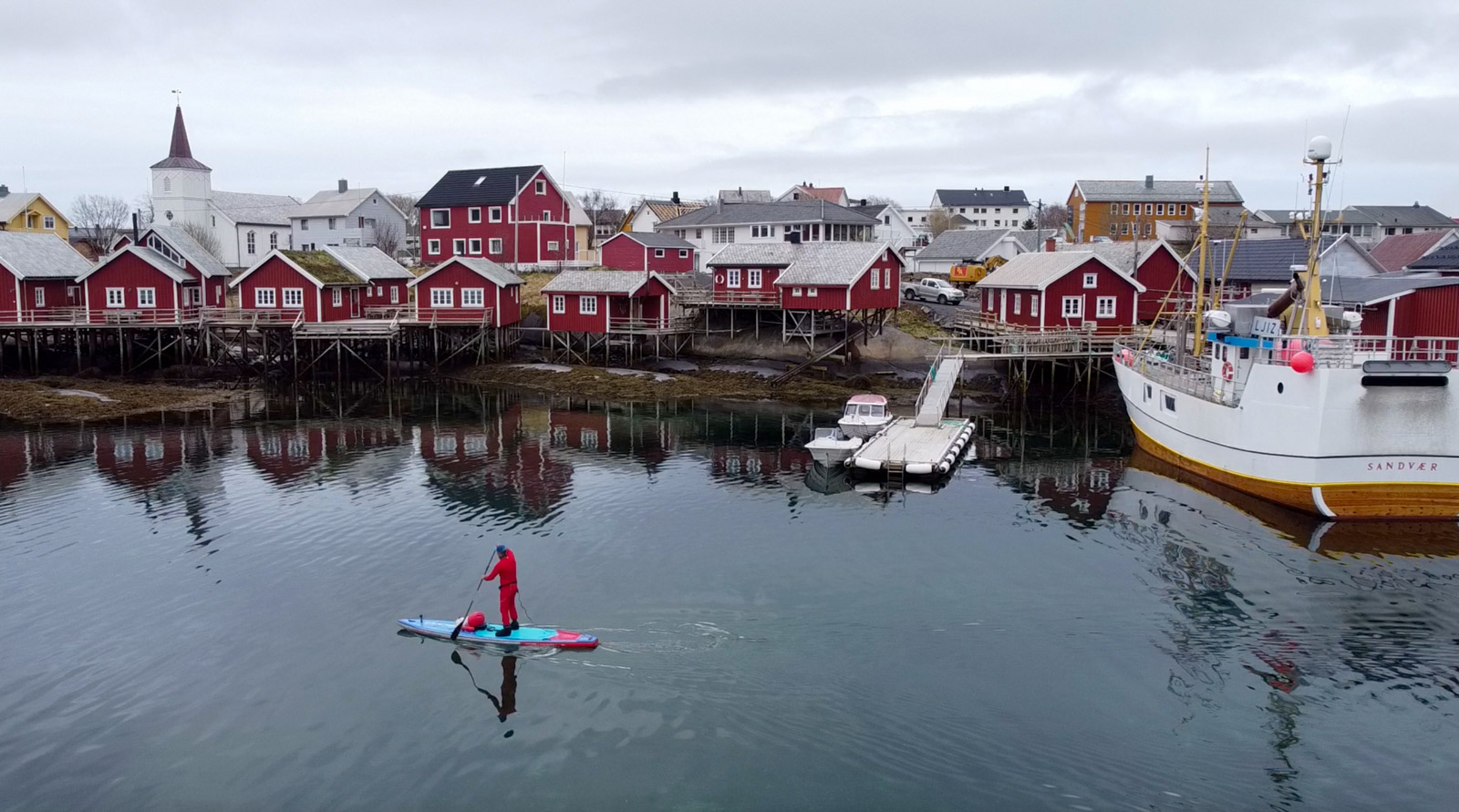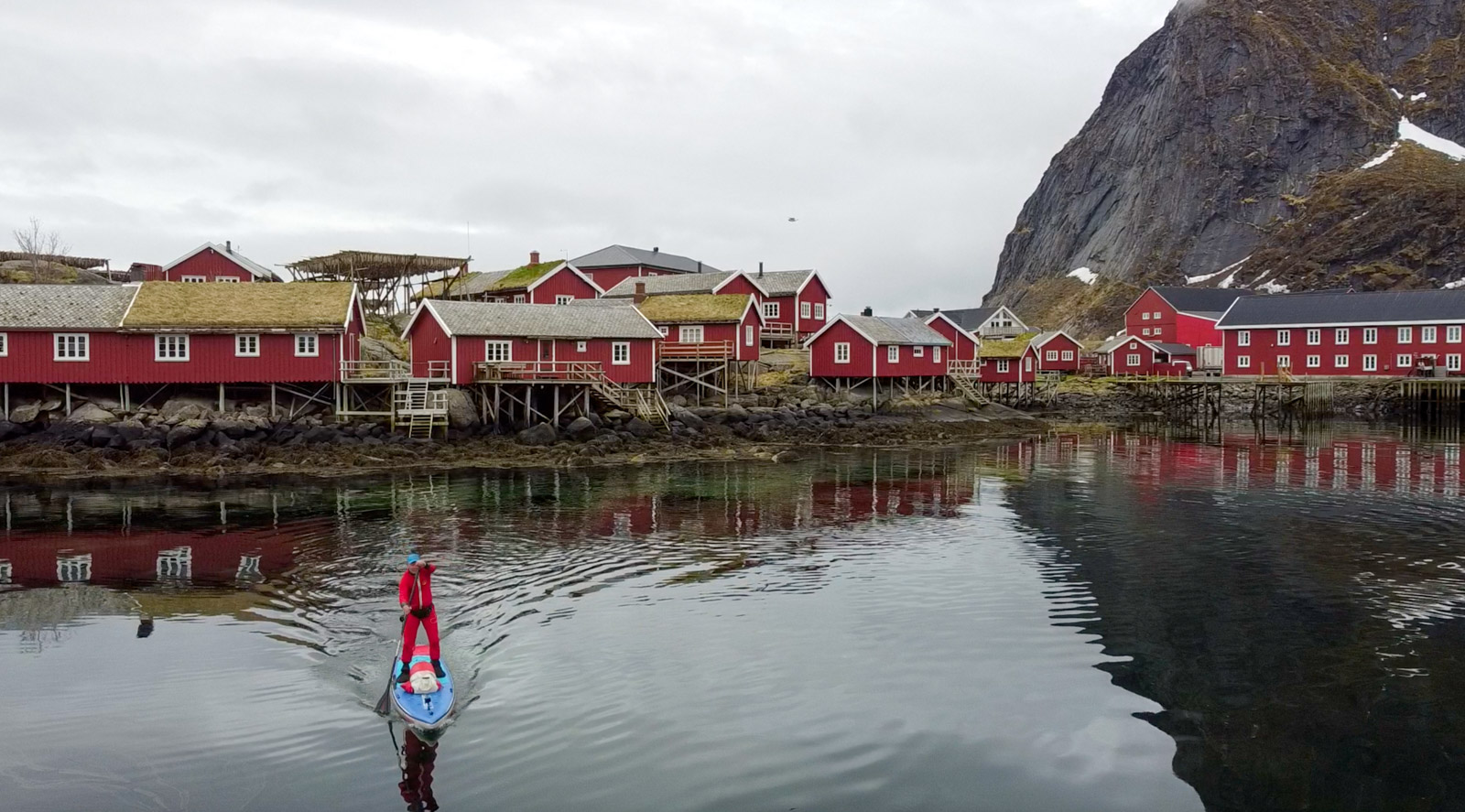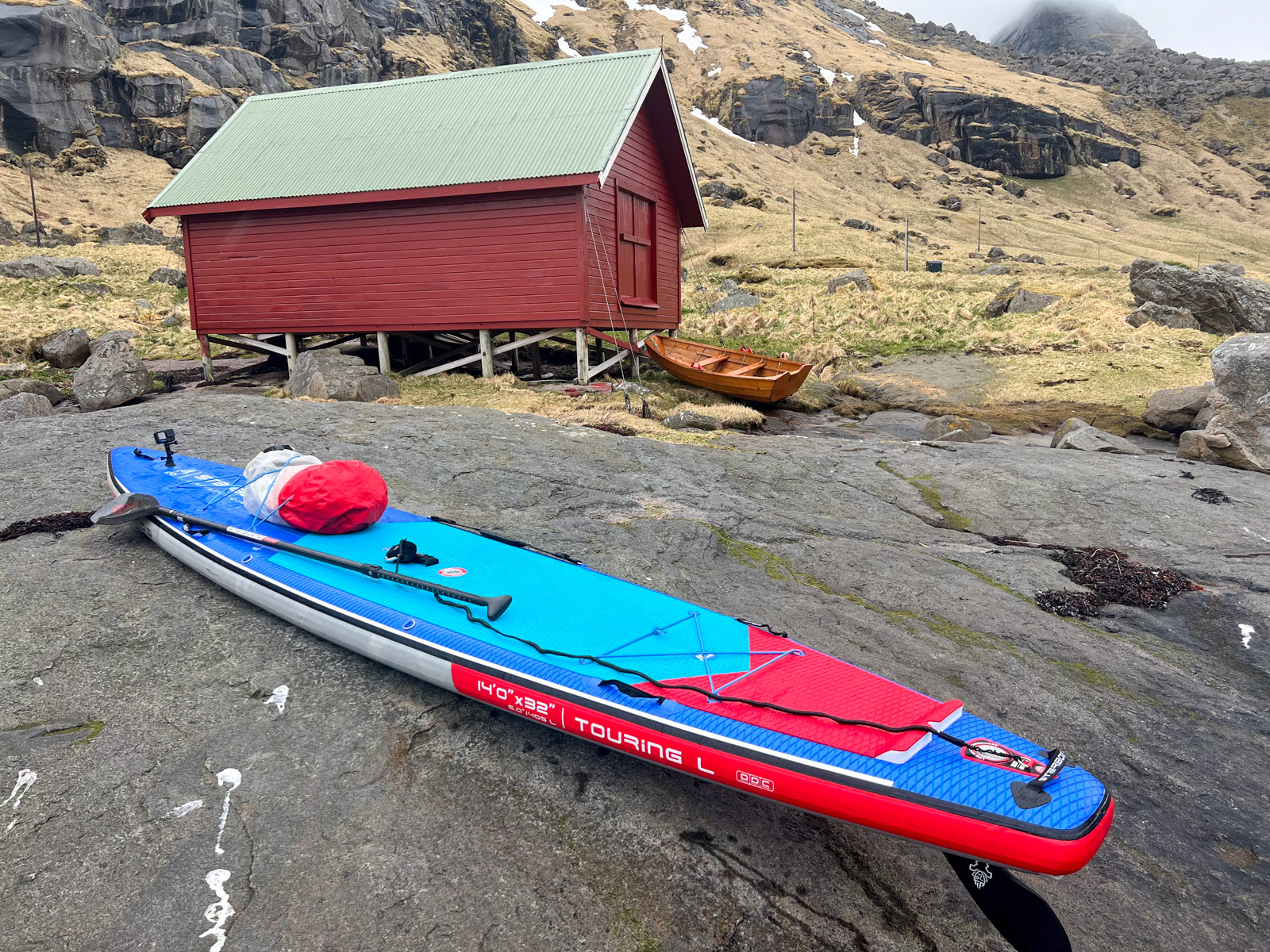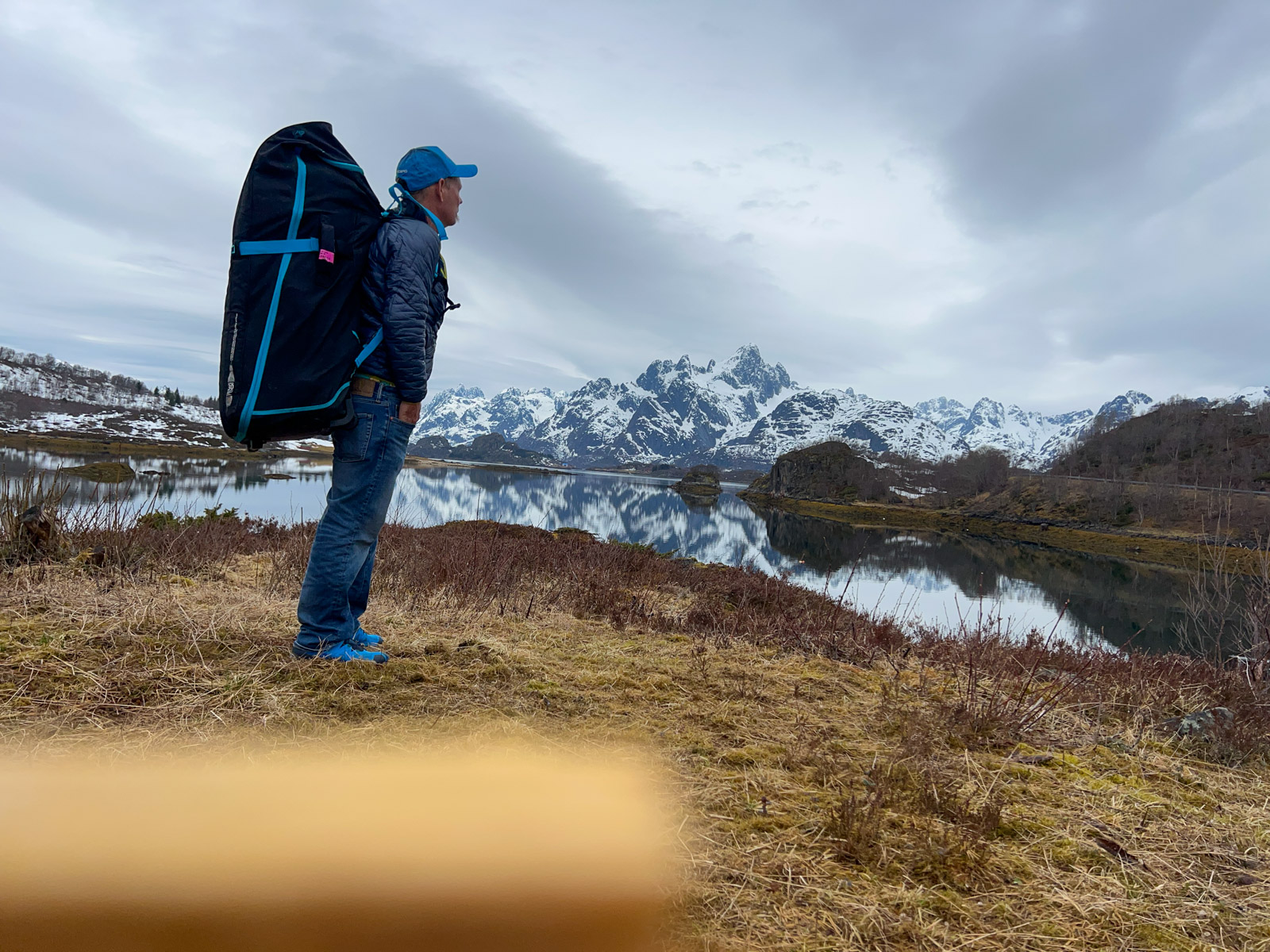LOFOTEN, Norway – As the world whizzes by on their hectic schedules, there are those who yearn for a change of pace, a break from the ordinary, and an adventure that takes them far from the beaten path. One such adventurer is Starboard Team Rider Bart de Zwart, whose life is usually spent sailing the seas with clients in exotic destinations. Bart recently embarked on a unique journey to Norway’s picturesque Lofoten archipelago. In this story, we follow their daring escapade through icy waters, serene fjords, and encounters with captivating wildlife. It’s a tale of roughing it, solitude among towering mountains, and a deep connection with nature.
It is time for a new paddle adventure. I have been walking around with this in my head for quite some time now. My wife and I spend our lives nowadays on a catamaran, sailing with clients to remote wing, sup, surf, and kite spots. Although this is an exciting life full of adventure, I have less time to do stand-up paddle adventures in other places around the globe. An adventure for me could be anywhere as long as it involves; a big change in surroundings, which could be nature or culture or a big challenge.
I had a small window between family visits, dental appointments, and going back tour boat in French Polynesia. I had my eye on Norway for quite some time—a large and beautiful country full of warm and welcoming people. Svein, founder and owner of Starboard is a proud Norwegian; he had always told me about Lofoten. This is an archipelago in Norway. It’s known for its dramatic scenery, high mountains, and deep Fjords and lies just above the Arctic Circle. I checked the weather, and the decision was made quickly. I bought tickets, packed the essentials, and five days later, I was there.
I also rented a small car to get me to good starting points for my paddle adventures. It was May, the temperatures were still very low (0-12 degrees Celius), and snow was everywhere! I flew into Tromso, found my small car, and drove to the archipelago. I traveled light. All I brought was my Starboard 14 x 32 Touring inflatable, a 3-piece Lima paddle, two small drybags, a bivak bag, a water bag, and some warm clothing. It all fits in my inflatable bag and one small duffel bag.
This trip, I was going to rough it. Sleep in the car or in my bivak bag outside if the weather was good enough, buy food where I could, and see where I would go every day. My first paddle adventure was Trollfjorden, a deep fjord with high mountain ranges on both sides. I got lucky with the weather; although it rained most of the night, the sun broke out in the morning. You won’t see many people or other paddles around these areas. Plenty of adventurists are heading here early to beat the ‘crowds’ on the road. For most people, it is too far, too cold, but it is so worth its nature, and the scenery is astonishing. I was happy I still had my SupSkin drysuit, which was made for me for the Yukon 1000-mile race; back then, the weather was so warm that we hardly used it, but I used it every day here in Norway.
I paddled for a few hours to get to the Fjord, and then once inside, I kept looking to the sides rising high up, layered with snow. The snow was melting; this made for some pretty spectacular waterfalls.
I read that even though some cruise ships enter this fjord, it is narrow enough to make that very exciting, but today I was by myself. I felt pretty insignificant next to the giant rock formations without a sole around.
The next two days, I visited the small fishing villages and paddled short trips to Fredvang, the start of my next paddle adventure. It was windy and slightly offshore. It took me a few hours to get around the North to the valley Stokkvikelva in Lofotodden National Park, a broad, lush green valley with nothing but a tiny little hut just big enough to give shelter to a passing hiker or paddler. Even though this was only a few hours from the village, it felt like I was at the end of the world, all by myself. Lonely but at the same time remarkedly beautiful. I contemplated staying here for a few days, but there was still so much more to see, so on I went. The next night I slept at one of the deserted beaches, but rain put me back in the car for the night.
There is a small island just offshore named Bleiksøya. One of the few gathering places for Puffin birds. You know, those cute small birds with a big round beaks. I slept on the beach right in front of the island. I woke up early because the winds were supposed to be lighter in the morning but would gather strength up to 30 knots during the day.
With the strong side wind, the 3 km paddle to Bleiksøya was not easy, and I was glad when I made it onto the island. Again I was all by myself amidst literally thousands of birds.
The most numerous of the birds out on Bleiksøya Island is the puffin. Around 80,000 breeding pairs come to Bleik every year, arriving on 14 April and departing on 10 August. These dates remain virtually unchanged from one year to the next, only varying by a day or two in some years. Again, animals with such feelings for timing and direction fascinate me.
On the mountain of Bleiksøya, I also saw many White-tailed (sea) eagles gliding on the winds, seemingly without effort, just riding the endless winds with their wingspan of up to 2.7 meters. With a good effort, I returned to the same beach I started from. I somehow expected to be blown more downwind and have to walk back to the car. I enjoyed a Norway breakfast (muesli with yoghurt and fruit) with a view of the island full of birds.
A captivating place and a worthy end to this fantastic time in the Lofoten. The following day I had a beautiful drive back to Trømso and flew back the next day on to the next adventure.
The next town was one of my favorites Reine, a colorful, picturesque small Norwegian fishing village with their typical Bordeaux red, brown, and yellow houses, fishing boats, and drying of the stockfish everywhere. Maybe I liked it so much because I spotted some orcas, a big group of about 8 outside the village. For me, orcas are a fascinating, intelligent, and graceful species.
The following day I pumped up the board again and paddled inside the fjords. Reine has an inside lake with three fjords sticking out as fingers. I paddled the first Forsfjorden, a shorter but spectacular Fjord with again some lovely waterfalls. Next, I battled the north wind to go to VindFjorden. The tide was going out, and I had to walk the last kilometer because I ran out of water. At the end of the Fjord, I hiked over the mountain to the other side to a giant beautiful beach. On the top of the mountain, I stopped for some food, but I couldn’t sit around too long. The wind was cold, and I had to stay moving. I found a small restaurant and had some well-deserved fish for dinner. The following day I visited the Lofotr Viking Museum in Bøstad. A great way to see how the Vikings who lived here not only survived the harsh winters but also thrived in this environment. I relied on the small supermarkets you can find in every small town to supply food and drinks. I was inspired by the orcas and wanted to see more of the water wildlife, so I decided to drive all the way up north to Andenes. I read that there is a gathering place for whales. I didn’t realize that the gathering place is about 10 km offshore, and with the 20 knots winds, I thought it wouldn’t be wise to paddle that far offshore. So I changed planes and went to the next coastal town Bleik.
Prepare for your SUP adventure to Lofoten, Norway
Best time of the year:
May – September, long days and ok temperatures.
February – March, beautiful snow landscapes and a chance to see the Northern lights but cold
What to bring:
Warm clothing, Gore-Tex jacket or drysuit
How to get there and around:
Flight to Narvik or Tromso.
It is helpful to have a small car to get around. You can drive the entire archipelago (300km) connected with bridges and tunnels.
Weather:
Even in the summer, the weather can be warm, cold, rough, windy, sunny, and most likely all of the above on the same day.
Best paddleboarding gear to bring:
Starboard Touring 14’ x 32” with double chamber. The double chamber makes the board stiffer, but I like the double chamber for safety in colder waters. Whatever happens, you have two separate floating devices.
Starboard Lima Carbon in 2 piece adjustable. 2 piece makes it more practical for travelling but also is durable, lightweight and offers great performance for a long-distance adventure by paddleboard.


























